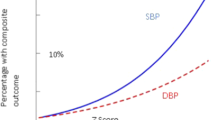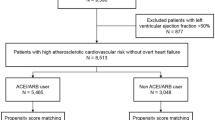Abstract
It remains to be determined whether the evidence in Western countries for blockade of the renin–angiotensin System in cardiovascular diseases could be directly applied to East Asian races including the Japanese population as a long-term strategy. The KYOTO HEART Study (KHS) is designed to investigate the add-on effect of valsartan versus conventional anti-hypertensive treatment on cardiovascular morbidity and mortality in Japanese hypertensive patients with uncontrolled blood pressure and with high cardiovascular risk. Over 3000 high-risk Japanese patients with uncontrolled hypertension were randomised to receive either additional treatment with valsartan or conventional non-angiotensin receptor blocker therapies, and the follow-up period will be at least 3 years. The primary end point is a composite of defined cardio- or cerebro-vascular events. Secondary end points include all causes of mortality, worsening of cardiac function, new onset or worsening of arrhythmias or diabetes mellitus. The KHS will provide new evidence for the management of blood pressure in hypertensive patients with high risk.
This is a preview of subscription content, access via your institution
Access options
Subscribe to this journal
Receive 12 digital issues and online access to articles
$119.00 per year
only $9.92 per issue
Buy this article
- Purchase on Springer Link
- Instant access to full article PDF
Prices may be subject to local taxes which are calculated during checkout

Similar content being viewed by others
References
The Sixth Report of the Joint National Committee on prevention, detection, evaluation, and treatment of high blood pressure. NIH Publication No 98-4080, 1997.
Bonow RO, Smaha LA, Smith Jr SC, Mensah GA, Lenfant C . World Heart Day 2002: the international burden of cardiovascular disease: responding to the emerging global epidemic. Circulation 2002; 106: 1602–1605.
Word Health Organization. Death and DAILY estimates for 2002 by cause for WHO member states: burden of disease statistics (available at http://www.who.int/entity/healthinfo/statistics/bodgbddeathdalyestimates.xls).
Kubo M, Kiyohara Y, Kato I, Tanizaki Y, Arima H, Tanaka K et al. Trends in the incidence, mortality, and survival rate of cardiovascular diseases in a Japanese community: the Hisayama study. Stroke 2003; 34: 2349–2354.
Tanizaki Y, Kiyohara Y, Kato I, Iwamoto H, Nakayama K, Shinohara N et al. Incidence and risk factors for subtypes of cerebral infarction in a general population: the Hisayama study. Stroke 2000; 31: 2616–2622.
Miyazaki T, Hirata M, Moriyama K, Sasaki Y, Aono H, Saito T et al. Metabolic syndrome in Japan diagnosed with visceral fat measurement by computed tomography. Proc Japan Acad 2005; 81: 471–479.
Calle E, Thun M, Petrelli J, Rodriguez C, Health C . Body-mass index and mortality in a prospective cohort of U.S. adults. N Eng J Med 1999; 341: 1097–1105.
Brown NJ, Vaughan DE . Angiotensin-converting enzyme inhibitors. Circulation 1998; 97: 1411–1420.
Hollenberg NK . European society of cardiology: angiotensin II antagonists in hypertension and beyond. Angiotensin II antagonists: why is there so much excitement? Am J Managed Care 1998; 4 (suppl 7): S384–S387.
Yusuf S, Sleight P, Pogue J, Bosch J, Davies R, Dagenais G . Effects of an angiotensin-converting-enzyme inhibitor, ramipril, on cardiovascular events in high-risk patients. N Engl J Med 2000; 342: 145–153.
Dahlöf B, Devereux RB, Kjeldsen SE, Julius S, Beevers G, de Faire U et al. Cardiovascular morbidity and mortality in the Losartan Intervention For Endpoint reduction in hypertension study (LIFE): a randomised trial against atenolol. Lancet 2002; 359: 995–1003.
Vyssoulis GP, Karpanou EA, Kyvelou SM, Adamopoulos DN, Antonakoudis GC, Deligeorgis AD et al. Beneficial effect of angiotensin II type 1 receptor blocker antihypertensive treatment on arterial stiffness: the role of smoking. J Clin Hypertens 2008; 10: 201–207.
Miura Y, Yamamoto N, Tsunekawa S, Taguchi S, Eguchi Y, Ozaki N et al. Replacement of valsartan and candesartan by telmisartan in hypertensive patients with type 2 diabetes: metabolic and antiatherogenic consequences. Diabetes Care 2005; 28: 757–758.
The ONTARGET Investigators. Telmisartan, ramipril or both in patients at high risk for vascular events. N Engl J Med 2008; 358: 1547–1559.
Dzau VJ, Antman EM, Black HR, Hayes DL, Manson JE, Plutzky J et al. The cardiovascular disease continuum validated: clinical evidence of improved patient outcomes: part II: clinical trial evidence (acute coronary syndromes through renal disease) and future directions. Circulation 2006; 114: 2871–2891.
Mochizuki S, Dahlöf B, Shimizu M, Ikewaki K, Yoshikawa M, Taniguchi I et al. Valsartan in a Japanese population with hypertension and other cardiovascular disease (Jikei Heart Study). Lancet 2007; 369: 1431–1439.
Ogihara T, Nakao K, Fukui T, Fukiyama K, Ueshima K, Oba K et al. Effects of candesartan compared with amlodipine in hypertensive patients with high cardiovascular risks: candesartan antihypertensive survival evaluation in Japan trial. Hypertension 2008; 51: 393–398.
Hansson L, Hedner T, Dahlöf B . Prospective randomized open blind endpoint (PROBE) study. A novel design for intervention trials. Blood Press 1992; 1: 113–119.
Japanese Society of Hypertension Guidelines Subcommittee for the Management of Hypertension. Guidelines for the management of hypertension for general practitioners. Hypertens Res 2001; 24: 613–634.
Kannel WB, Gordon T, Castelli WP, Margolis JR . Electrocardiographic left ventricular hypertrophy and risk of coronary heart disease: the Framingham Study. Ann Intern Med 1970; 72: 813–822.
Pocock SJ, Simon R . Sequential treatment assignment with balancing for prognostic factors in the controlled clinical trial. Biometrics 1975; 31: 103–115.
Lang RM, Bierig M, Devereux RB, Flachskampf FA, Foster E, Pellikka PA et al. Recommendations for Chamber Quantification: a Report from the American Society of Echocardiography's Guidelines and Standards Committee and the Chamber Quantification Writing Group, Developed in Conjunction with the European Association of Echocardiography, a Branch of the European Society of Cardiology. J Am Soc Echocardiogr 2005; 18: 1440–1463.
Wang MSR, Lagakos SW, Ware JH, Hunter DJ, Drazen JM . Statistics in medicine-reporting of subgroup analyses in clinical trials. N Engl J Med 2007; 357: 2189–2194.
Acknowledgements
Role of the funding source: The study was funded by Kyoto Prefectural University School of Medicine, with an unrestricted grant from Novartis Pharma KK, Japan. The sponsor had no role in study design, data collection, data analysis, data interpretation or writing of the report. The executive committee will have full access to all the data at the end of the study, and has final responsibility for the decision to submit for publication.
Author information
Authors and Affiliations
Consortia
Corresponding author
Appendix
Appendix
Organisation and data management
Matsubara H supervises the KYOTO HEART Study (KHS) as the chief investigator, and several staff have been appointed by the chief investigator to support the management of the study as representatives of the KHS group secretariat. The KHS is administered by the Steering Committee, which is composed of academic leaders appointed by the chief investigator. The role of the Steering Committee is to supervise the overall execution of the study.
In the KHS, the Data and Safety Monitoring Board (DSMB), the Endpoint Committee and the Safety Committee are organised independently from the study group and each organisation consists of three external experts. The DSMB members are blinded to the allocation of drug treatment groups, meet periodically, have a stopping guideline for terminating the trial prematurely and make recommendations to the Steering Committee about the ethical aspects of trial continuation by evaluating each case of possible adverse events. This study will finish when the number of primary endpoints reaches the hypothesis after the end of enrolment. The DSMB will review the effectiveness and safety of the study at regular intervals. This board executes three interim analyses, with the O'Brien–Fleming method. Yagi K, who is a chief biostatistician at the Louis Pasteur Center for Medical Research, Kyoto, Japan, appointed the DSMB members consisting of two physicians who are independent of the study. The Endpoint Committee and the Safety Committee are blinded to the allocation of drug treatment groups and the results of the study, and are managed separately from investigators and biostatisticians. The Safety Committee has the role to oversee the welfare of patients enroled in the trial from the ethical point of view. In addition, the Substudy committee is organised according to the agreement of the Steering Committee. Investigators are blinded to the allocation of drug treatment groups and the results of the study until the discontinuation report from the DSMB or the final report of the study data analysis is announced.
Data collection and management, and allocation for drug treatment groups are conducted by the automatic electronic data-capturing system using the wide area network with a secure server managed by the data centre in Kobe, which is independent of the study implementation group. The statistical analysis of the data is performed by the biostatisticians at the Louis Pasteur Center for Medical Research, Kyoto, Japan, who are blinded to the allocation of drug treatment groups and independent of the study implementation group and the funding source. The Data monitoring team periodically visits randomly selected investigators to check the suitability between the hospital data and the input data presented by internet network system.
Executive committee
H Matsubara, Department of Cardiovascular Medicine, Kyoto Prefectural University of Medicine is the study chairman. B Dahlöf, Department of Medicine, Sahlgrenska University Hospital/Östra, Göteborg, Sweden, is the honorary supervisor of the logistics, and conducts the reporting of the study.
Steering committee
Kyoto Prefectural University of Medicine—T Sawada (Main Steering Committee Member), T Shirayama, Y Mori, M Okigaki, A Matsumuro, H Yamada, Y Tsutsumi, M Matoba, T Takahashi, H Shiraishi, K Ikeda, T Nakamura and T Yamada; National Hospital Organization Maizuru Medical Center—S Hirano; National Hospital Organization Shiga Hospital—A Azuma; Kyoto Prefectural Yosanoumi Hospital—S Kimura; Akashi Municipal Hospital—S Sasaki; Ayabe City Hospital—K Shiga; Omihachiman Community Medical Center—K Maki; Kyoto City Hospital—K Furukawa; Kumihama Hospital—S Okuda; Nantan General Hospital—Y Kajita; Fukuchiyama City Hospital—M Nishio; Kyoto First Red Cross Hospital—Y Kohno; Kyoto Second Red Cross Hospital—M Kitamura; Maizuru Red Cross Hospital—K Nishida; Saiseikai Kyoto Hospital—Y Yamahara; Saiseikai Shiga Hospital—T Nakamura; Uji Hospital—S Sawada; Gakkentoshi Hospital—R Sakai; Kameoka Municipal Hospital—T Kuriyama; Kyoto Kizugawa Hospital—H Miyanaga; Kyoto Interdisciplinary Institute Hospital of Community Medicine—T Kitani; Social Insurance Kyoto Hospital—H Haruyama; Shakaihoken Kobe Central Hospital—A Nishio; Kouseikai Takeda Hospital—N Kinoshita; Aijyukai Dohjin Hospital—S Inagaki; Matsushita Memorial Hospital—H Sugihara; Aiseikai Yamashina Hospital—M Katamura; Midorigaoka Hospital—T Hachiya; Asahi University Murakami Memorial Hospital—S Kato; Meiji University of Oriental Medicine Hospital—K Ohtsuki.
Endpoint committee
J Higaki, Department of Integrated Medicine and Informatics, Ehime University Graduate School of Medicine, Shitsukawa, Japan; S Kim-Mitsuyama, Department of Pharmacology and Molecular Therapeutics, Kumamoto University Graduate School of Medical Sciences, Kumamoto, Japan; T Ichiki, Department of Cardiovascular Medicine, Kyushu University Graduate School of Medical Sciences, Fukuoka, Japan.
Safety committee
M Kitakaze, Department of Cardiovascular Medicine, National Cardiovascular Center, Osaka, Japan; T Sugiura, Department of Clinical Laboratory Medicine, Kochi Medical School, Kochi University, Kochi, Japan; H Rakugi, Department of Geriatric Medicine, Osaka University Graduate School of Medicine, Suita, Japan.
Data and safety monitoring board
K Yagi, Louis Pasteur Center for Medical Research, Kyoto, Japan; K Kanda, Department of Cardiovascular surgery, Division of Surgery, Graduate School of Medical Science, Kyoto Prefectural University of Medicine, Kyoto, Japan; C Sakakura, Department of Digestive Surgery, Division of Surgery, Graduate School of Medical Science, Kyoto Prefectural University of Medicine, Kyoto, Japan.
Statistical analysis organization
K Yagi, Louis Pasteur Center for Medical Research, Kyoto, Japan; Nobuo Shirahashi, Department of Preventive Medicine and Environmental Health, Osaka City University Medical School, Osaka, Japan.
Data monitoring board
M Miki, Kyoto Prefectural University School of Medicine, Kyoto, Japan; S Toyoda, Kyoto Prefectural University School of Medicine, Kyoto, Japan.
Rights and permissions
About this article
Cite this article
Sawada, T., Takahashi, T., Yamada, H. et al. Rationale and design of the KYOTO HEART study: effects of valsartan on morbidity and mortality in uncontrolled hypertensive patients with high risk of cardiovascular events. J Hum Hypertens 23, 188–195 (2009). https://doi.org/10.1038/jhh.2008.116
Received:
Revised:
Accepted:
Published:
Issue Date:
DOI: https://doi.org/10.1038/jhh.2008.116



